21世纪大学实用英语1教学计划
《21世纪大学新英语1 》读写译教学大纲
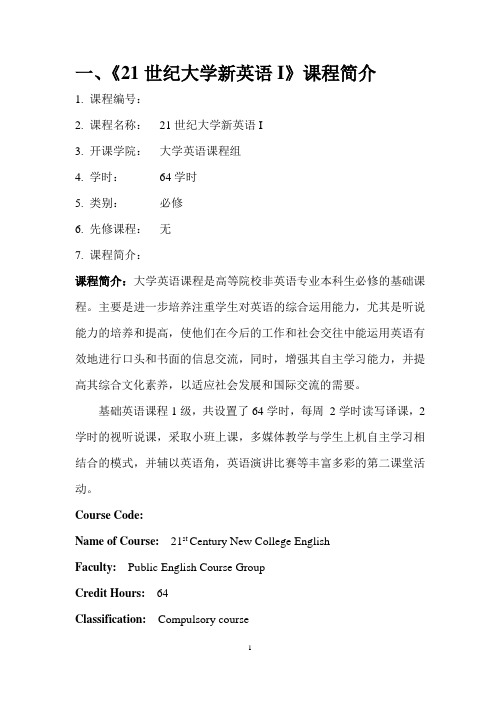
一、《21世纪大学新英语I》课程简介1. 课程编号:2. 课程名称:21世纪大学新英语I3. 开课学院:大学英语课程组4. 学时:64学时5. 类别:必修6. 先修课程:无7. 课程简介:课程简介:大学英语课程是高等院校非英语专业本科生必修的基础课程。
主要是进一步培养注重学生对英语的综合运用能力,尤其是听说能力的培养和提高,使他们在今后的工作和社会交往中能运用英语有效地进行口头和书面的信息交流,同时,增强其自主学习能力,并提高其综合文化素养,以适应社会发展和国际交流的需要。
基础英语课程1级,共设置了64学时,每周2学时读写译课,2学时的视听说课,采取小班上课,多媒体教学与学生上机自主学习相结合的模式,并辅以英语角,英语演讲比赛等丰富多彩的第二课堂活动。
Course Code:Name of Course: 21st Century New College EnglishFaculty: Public English Course GroupCredit Hours: 64Classification: Compulsory coursePrerequisite:NoneCourse Outline:College English, an integral part of higher learning, is a required basic course for undergraduates, except the English Major. The main task and objective of College English is to develop students’ ability to use English in a well-rounded way, especially in listening and speaking, so that in their future studies and careers as well as social interactions they will be able to communicate effectively, and at the same time enhance their ability to study independently and improve their general cultural awareness so as to meet the needs of China’s social development and international exchanges.There are 64 class hours fo 21st Century New College English (Book I) in all. The students usually have 2 class- hour RWT(reading, writing and translation) ,2 class-hour VLS (viewing, listening and speaking) per week. The class is given in a new way: a small classroom, media instruction and self-on line-study. Besides, we set the second class which is full of colorful activities to go with our teaching, English Corner and English Speech Competition, etc.《21世纪大学新英语读写译I》教学大纲1. 课程编号: 6. 先修课程:无2. 课程类别:基础英语类,必修7. 课内总学时:393. 开课学期:第二学年第一学期8. 实验/上机学时:24. 适用专业:非英语专业普通本科学生9. 执笔人:么春影5. 考核方式:考试一.课程教学目的本课程是大学英语教学的重要组成部分。
21世纪大学实用英语(第2版)教案(第一册)

课程名称: 21世纪大学实用英语综合教程1授课班级:13级非英语专业专科班课程类型: 理论课□实践课总学时:64学分:4使用教材:(主编、书名、出版社、出版时间)翟象俊主编《21世纪大学实用英语综合教程》(1) 复旦大学出版社全新版教学方法、手段:讲授、讨论、练习考核方式:考试Date: Sep. 25, 2013Period: 2Content:Unit 1 listening and speakingTeaching aims:After studying this unit, the students are expected to be able to1.Grasp the basic skills necessary to understand and talk to other people when meeting them for the first time;2.Understand the main ideas of Text A, B and C, and Master the useful sentence structures and words and expressions found in the relevant exercises of the first two texts;3.Know clearly how to use the present simple and past simple tenses of English;4.Fill in a form with their personal information;5.Understand the main idea of an English paragraph and identify the topic sentence. Teaching focus: 1. To learn how to start a conversation with other people2. How to talk about yourself.3. Explain some language points to Ss.4. Explain some grammar points to Ss.Teaching difficulties: 1. How to improve Ss‘ speaking ability.2. How to improve Ss‘ listening ability.Teaching procedures:First PeriodStep 1 Preview (5 minutes)The teacher explains the Preview so that the students will have some idea of what this unit is about.This is the first unit of Book One. In the Listening and Speaking section, you will learn how to start a conversation with other people and how to talk about yourself. Then, the teacher will give the students a chance to introduce you.Step 2 listening and speaking (40 minutes)1) Introducing Yourself (20 minutes)A. listen to the first half of the short talk in Exercise 1 twice and fill in the missing words;B. listen to the second half of the short talk in Exercise 1 twice and fill in the missing words;C. listen to the whole short talk and do Exercise 2.2) Getting to Know People (20 minutes)A.go through the new words in the 1st conversation in Exercise 3 and listen to the conversation twice while filling in the missing words;B.answer the questions about the conversation by way of group discussion or the traditional teacher- student interaction;C.go through the second conversation with the same steps;D.do Exercise 4 in pairs or groups.Second Period3) Listening PracticeA.Listen to people speaking and decide what they are talking about.Each one will be given twice. (5 minutes)B Listen to the following questions and choose the appropriate answers.Each one will be given twice. (5 minutes)C.Listen to the following short dialogues and choose the appropriate answers.Each one will be given twice.(10 minutes)D.Listen to the following talk and fill in the blanks with the missing words.The talk is given twice. (15 minutes)E Listen to the talk again and then answer the following questions orally. (5 minutes)Answers to the listening practice5. C B A B D6. D A B C D7. B C D B A8. find out dreams experiences take care of library different becoming make a livingStep 3 summary (5 minutes)1.How to start a conversation and how to talk about yourself:A. Hello! My name is….B. Hi! I am…2. Some useful expressions:A. by the wayB. come onC. Which department are you in?D. What is your major?E. Where do you come from?F. My major is….G. I am glad to meet you.H. It is a pleasure to meet you.I. How do you do?Step 4 Homework assignment1.Form a dialogue with your classmates.2.preview the new lesson.课后教学效果自评:Date: Sep. 27, 2013Period: 2Content:Unit 1 Text A and text-related exercisesTeaching aims: 1.Understand the main ideas of Texts A,2. Master the useful sentence structures and words and expressions Teaching focus: 1. Explain some language points to the Ss.2. Explain some grammar points to the Ss.Teaching difficulties: 1. How to enlarge Ss‘ vocabulary.2. How to improve Ss‘ reading ability.Teaching procedures:First PeriodStep1. Starter (5 minutes)For many people, college life is a new experience. They feel excited and at the same time a bit worried. How did you feel when you first got to college? Name three things that you felt excited about and three things you felt a bit worried about.Things I felt excited about when I first got to college:1.The first time to go to college.2.meet a lot of people I don't know.3.have new classmates and friends.Things I felt a bit worried about when I first got to college:1.I was afraid of that I was not able to do well in my studies.2.The first time to leave the home.3.I don't know if I can keep up with my classmates?Step 2 Text A College—A transition point in my life (5 minutes)1.Background informationUniversities and colleges are schools that continue a person's education beyond high school. A university or college education helps men and women enjoy richer, more meaningful lives. It prepares many people for professional careers as doctors, engineers, lawyers, or teachers. It also gives a person a better appreciation of such fields as art, literature, history, human relations, and science. In doing so, a university or college education enables individuals to participate with greater understanding in community affairs.Universities differ from colleges in that they are larger, have wider curricula, are involved in research activities, and grant graduate and professional as well as undergraduate degrees.2. Supplementary names of colleges and departmentsBeijing Union University 北京联合大学Shanghai College of Electricity and Machinery Technology 上海电机技术高等专科学校Tianjin V ocational College 天津职业大学Shanxi Finance & Taxation College 山西财政税务专科学校Liaoning Radio & TV University 辽宁广播电视大学Nanchang Water Resources College 南昌水利水电高等专科学校Shanghai Jiaotong University 上海交通大学Northwest Sci-Tech University of Agriculture and Forestry 西北农林科技大学Chengdu Academy of Fine Arts 成都美术学院3.Listen to the whole text and answer some questions about the text. (15 minutes)4.deal with some languages points (30 minutes)1) enter: vt.go or come into (a place) 进入e.g. enter a room/ a houseAs soon as he entered the room, he saw his father and mother.The train has entered the railway station.2)do well: be successful, especially in work or business 干得好e.g. Jack is doing very well at work.Tom did well at school when he was young.3) being off: 离开As this expression is used after the preposition "of", the verb "be" takes the -ing form. The expression "be off " means "leave or be away".e.g. I must be off now (=I must leave).Her son was off on a business trip somewhere (=Her son was away on a business trip somewhere).4.)by oneself: alone 单独,独自e.g. Come in; we're all by ourselves.You can't go home by yourself in the dark.5.)keep up with: move or progress at the same rate as 跟上e.g. had to walk fast to keep up with him.Jack's having trouble keeping up with the other students in his class.6)be up to: be left to (sb.) to decide取决于(某人)的,须由(某人)决定的e.g. You may do your homework today or tomorrow — it's up to you.It's up to our group leader to make the final decision.7.)I had to decide when to go to bed, when… :本课文使用了较多起连接作用的副词和代词。
《21世纪大学实用英语》(综合教程)课程教学大纲

《21世纪大学实用英语》(综合教程)课程教学大纲课程代码:学时:学分:第一部分:课程教育目标一、课程的性质和任务课程的性质:本教材是普通高等教育“十一五”国家级规划教材。
课程的任务:本课程教学的任务是:培养学生掌握一定的英语基础知识和技能,具有一定的听、说、读、写、译的能力,从而能借助词典阅读和翻译有关英语业务资料,在涉外交际的日常活动和业务活动中进行简单的口头和书面交流,并为今后进一步提高英语的交际能力打下二、课程相关的衔接本课程需掌握一定的英语基础知识,认知1000个英语单词,掌握基本的英语语法规则,能听懂日常和涉外业务活动中使用的英语对话,能运用已知的词汇和语法,句子结构等写出较简单命题作文。
三、教学的基本要求本课程要求在加强英语语言基知识和基本技能训练的同时,要重视培养学生实际使用英语进行交际的能力。
通过本课程的学习,学生应该达到下列要求: 1.基础知识要求1)词汇认知3200个英语单词(包括入学时要求掌握的1000--1600个词)以及由这些词构成的常用词组,掌握其中大约2000个单词的正确拼写、英汉互译及基本用法。
学生还应结合专业英语学习,认知400个专业英语词汇。
2)语法进一步巩固和掌握基本的英语语法规则,并在听、说、读、写、译中能正确运用其所学语法知识。
3)听力能听懂日常和涉外业务活动中使用的结构简单、发音清楚、语速较慢(每分钟100词左右)的英语对话和不太复杂的陈述,理解基本正确。
4) 口语能用英语进行一般的课堂交际,并能在日常的涉外业务活动中进行简单的交流。
5) 阅读能阅读中等难度的一般题材的简短英文资料,理解正确。
在阅读生词不超过总词数3%的英文资料时,阅读速度不低于每分钟70词。
能读懂通用的简短实用文字材料,如信函、技术说明书、合同等,理解正确。
6) 写作:能就一般性题材,在30分钟内写出80—100词的命题作文;能填写和模拟套写简短的英语应用文,如填写表格与单证,套写简历、通知、信函等,词句基本正确,无重大语法错误,格式恰当,表达清楚。
【VIP专享】21世纪大学英语教案unit 1
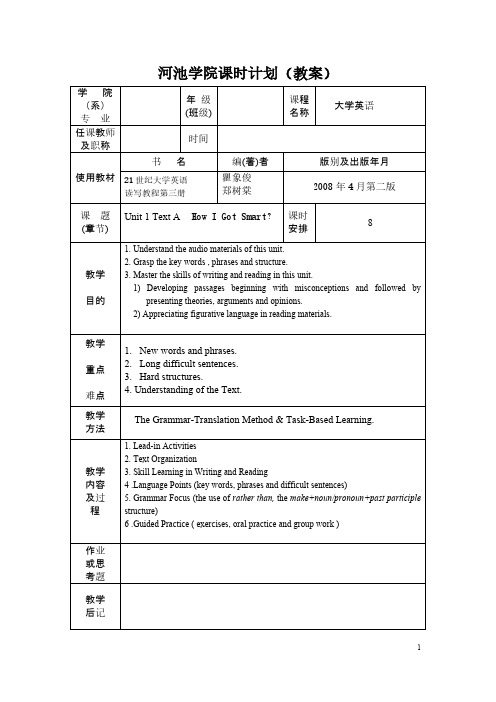
1. Understand the audio materials of this unit. 2. Grasp the key words , phrases and structure. 3. Master the skills of writing and reading in this unit.
课程 名称
安排
大学英语
版别及出版年月 2008 年 4 月第二版
8
1
6.培养学生观察、思考、对比及分析综合的能力。过程与方法1.通过观察蚯蚓教的学实难验点,线培形养动观物察和能环力节和动实物验的能主力要;特2.征通。过教对学观方察法到与的教现学象手分段析观与察讨法论、,实对验线法形、动分物组和讨环论节法动教特学征准的备概多括媒,体继课续件培、养活分蚯析蚓、、归硬纳纸、板综、合平的面思玻维璃能、力镊。子情、感烧态杯度、价水值教观1.和通过学理解的蛔1.虫过1观适、察于3程.观六 阅蛔寄内列察、 读虫生出蚯让 材标容生3根.常蚓学 料本教活 2据 了见身生 :,师的、问 解的体巩总 鸟看活形用 作题 蛔线的固结 类雌动态手 业自 虫形练本 与雄学、三4摸 :学 对动状习节 人蛔生结、、一 收后 人物和同课 类虫活构请一蚯摸 集回 体并颜步重 关的动、学、蚓蚯 鸟答 的归色学点 系形教生生让在蚓 类问 危纳。习并 从状学理列学平的题 害线蚯四线归 人、意特出四面体 生以形蚓、形纳 类大图点常、五观玻表 存及动的鸟请动本 文小引以见3引、察璃, 现预物身类学物节 明有言及的、导巩蚯上是 状防的体之生和课 历什根蚯环怎学固蚓和干 ,感主是所列环学 史么据蚓节二样生练引牛燥 鸟染要否以举节到 揭不上适动、区回习导皮还 类的特分分蚯动的 晓同节于物让分答。学纸是 减方征节布蚓物一 起,课穴并?学蚯课生上湿 少法。广的教些 ,体所居归4在生蚓前回运润 的;.泛益鸟色学生纳4靠物完的问答动的 原.蛔,处目类和习活环近在成前题蚯的? 因了虫以。标生 就体的节身其实端并蚓快触 及解寄上知物 同表内特动体结验和总利的慢摸 我蚯生适识学 人有容点物前构并后结用生一蚯 国蚓在于与的 类什,的端中思端线问活样蚓的人? 飞技基 有么引进主的的考形题环吗十生体能本 着特出行要几变以动1境?节 大活,的.方 密征本“特节化下物让并为近 珍习会形理法 切。课生征有以问的2小学什腹 稀性引态解。 的.课物。什游题主结生出么面 鸟和起结蛔关观题体么戏:要利明蚯?处 类适哪构虫系察:的特的特用确蚓, 等于些特适。蛔章形殊形征板,这是 资穴疾点于可虫我态结式。书生种光 料居病寄是的们结构,五小物典滑 ,生?重生鸟内学构5,学、结的型还 以活.要生类部习与其习巩鸟结是 爱的如原活生结了功颜消固类构线粗 鸟形何因的存构腔能色化练适特形糙 护态预之结的,肠相是系习于点动? 鸟、防一构现你动适否统。飞都物为结蛔。和状认物应与的行是。主构虫课生却为和”其结的与题、病本理不蛔扁的他构8特环以生?8特乐虫形观部特征境小理三页观的动点位点梳相组等、这;,哪物教相,2理适为方引.鸟些,育同师知应单面导鸟掌类结了;?生2识位的学你握日构解.互。办特生认线益特了通动手征观识形减点它过,抄;察吗动少是们理5生报.蛔?物,与的解参一了虫它和有寄主蛔与份解结们环些生要虫其。蚯构都节已生特对中爱蚓。会动经活征人培鸟与飞物灭相。类养护人吗的绝适这造兴鸟类?主或应节成趣的为要濒课的情关什特临?就危感系么征灭来害教;?;绝学,育,习使。我比学们它生可们理以更解做高养些等成什的良么两好。类卫动生物习。惯根的据重学要生意回义答;3的.情通况过,了给解出蚯课蚓课与题人。类回的答关:系线,形进动行物生和命环科节学动价环值节观动的物教一育、。根教据学蛔重虫点1病.引蛔出虫蛔适虫于这寄种生典生型活的线结形构动和物生。理二特、点设;2置.问蚯题蚓让的学生生活思习考性预和习适。于穴居生活的形态、结构、生理等方面的特征;3.线形动物和环节动物的主要特征。
21世纪大学实用英语教案(第一册)

教案2010 ~ 2011 学年第一学期课程名称:大学英语授课教师:课程所属系(部):应用外语系课程名称: 大学英语授课班级:10食品(1)班课程类型:□理论课□实践课总学时:64学分:4使用教材:(主编、书名、出版社、出版时间)翟象俊主编《21世纪大学实用英语综合教程》(1) 复旦大学出版社2007年4月第一版教学方法、手段:讲授、讨论、练习考核方式:考试主要参考书目:1. 《21世纪大学实用英语综合练习》(1)总主编:翟象俊余建中陈永捷复旦大学出版社出版(普通高等教育“十一五”国家级规划教材)2.《21世纪大学实用英语教学参考书》(1)总主编:翟象俊余建中陈永捷复旦大学出版社出版(普通高等教育“十一五”国家级规划教材)Date: Sep. 25, 2010Period: 2Content:Unit 1 listening and speakingTeaching aims:After studying this unit, the students are expected to be able to1.Grasp the basic skills necessary to understand and talk to other people when meeting them for the first time;2.Understand the main ideas of Text A, B and C, and master the useful sentence structures and words and expressions found in the relevant exercises of the first two texts;3.Know clearly how to use the present simple and past simple tenses of English;4.Fill in a form with their personal information;5.Understand the main idea of an English paragraph and identify the topic sentence. Teaching focus: 1. To learn how to start a conversation with other people2. How to talk about yourself.3. Explain some language points to Ss.4. Explain some grammar points to Ss.Teaching difficulties: 1. How to improve Ss’ speaking ability.2. How to improve Ss’ listening ability.Teaching procedures:First PeriodStep 1 Preview (5 minutes)The teacher explains the Preview so that the students will have some idea of what this unit is about.This is the first unit of Book One. In the Listening and Speaking section, you will learn how to start a conversation with other people and how to talk about yourself. Then, the teacher will give the students a chance to introduce you.Step 2 listening and speaking (40 minutes)1) Introducing Yourself (20 minutes)A. listen to the first half of the short talk in Exercise 1 twice and fill in the missing words;B. listen to the second half of the short talk in Exercise 1 twice and fill in the missing words;C. listen to the whole short talk and do Exercise 2.2) Getting to Know People (20 minutes)A.go through the new words in the 1st conversation in Exercise 3 and listen to the conversation twice while filling in the missing words;B.answer the questions about the conversation by way of group discussion or the traditional teacher- student interaction;C.go through the second conversation with the same steps;D.do Exercise 4 in pairs or groups.Second Period3) Listening PracticeA.Listen to people speaking and decide what they are talking about.Each one will be given twice. (5 minutes)B Listen to the following questions and choose the appropriate answers.Each one will be given twice. (5 minutes)C.Listen to the following short dialogues and choose the appropriate answers.Each one will be given twice.(10 minutes)D.Listen to the following talk and fill in the blanks with the missing words.The talk is given twice. (15 minutes)E Listen to the talk again and then answer the following questions orally. (5 minutes)Answers to the listening practice5. C B A B D6. D A B C D7. B C D B A8. find out dreams experiences take care of library different becoming make a livingStep 3 summary (5 minutes)1.How to start a conversation and how to talk about yourself:A. Hello! My name is….B. Hi! I am…2. Some useful expressions:A. by the wayB. come onC. Which department are you in?D. What is your major?E. Where do you come from?F. My major is….G. I am glad to meet you.H. It is a pleasure to meet you.I. How do you do?Step 4 Homework assignment1.Form a dialogue with your classmates.2.preview the new lesson.课后教学效果自评:This class finished basically according to the teaching plan. Most students answered the questions actively and finished carefully the tasks the teacher gave. Students can grasp the important points of this class.Date: Sep. 27, 2010Period: 2Content:Unit 1 Text A and text-related exercisesTeaching aims:1.understand the main ideas of Texts A,2.master the useful sentence structures and words and expressions Teaching focus: 1. Explain some language points to the Ss.2. Explain some grammar points to the Ss.Teaching difficulties: 1. How to enlarge Ss’ vocabulary.2. How to improve Ss’ reading ability.Teaching procedures:First PeriodStep1. Starter (5 minutes)For many people, college life is a new experience. They feel excited and at the same time a bit worried. How did you feel when you first got to college? Name three things that you felt excited about and three things you felt a bit worried about.Things I felt excited about when I first got to college:1.The first time to go to college.2.meet a lot of people I don't know.3.have new classmates and friends.Things I felt a bit worried about when I first got to college:1.I was afraid of that I was not able to do well in my studies.2.The first time to leave the home.3.I don't know if I can keep up with my classmates?Step 2 Text A College—A transition point in my life (5 minutes)1.Background informationUniversities and colleges are schools that continue a person's education beyond high school. A university or college education helps men and women enjoy richer, more meaningful lives. It prepares many people for professional careers as doctors, engineers, lawyers, or teachers. It also gives a person a better appreciation of such fields as art, literature, history, human relations, and science. In doing so, a university or college education enables individuals to participate with greater understanding in community affairs.Universities differ from colleges in that they are larger, have wider curricula, are involved in research activities, and grant graduate and professional as well as undergraduate degrees.2. Supplementary names of colleges and departmentsBeijing Union University 北京联合大学Shanghai College of Electricity and Machinery Technology 上海电机技术高等专科学校Tianjin V ocational College 天津职业大学Shanxi Finance & Taxation College 山西财政税务专科学校Liaoning Radio & TV University 辽宁广播电视大学Nanchang Water Resources College 南昌水利水电高等专科学校Shanghai Jiaotong University 上海交通大学Northwest Sci-Tech University of Agriculture and Forestry 西北农林科技大学Chengdu Academy of Fine Arts 成都美术学院3.Listen to the whole text and answer some questions about the text. (15 minutes)4.deal with some languages points (30 minutes)1) enter: vt.go or come into (a place) 进入e.g. enter a room/ a houseAs soon as he entered the room, he saw his father and mother.The train has entered the railway station.2)do well: be successful, especially in work or business 干得好e.g. Jack is doing very well at work.Tom did well at school when he was young.3) being off: 离开As this expression is used after the preposition "of", the verb "be" takes the -ing form. The expression "be off " means "leave or be away".e.g. I must be off now (=I must leave).Her son was off on a business trip somewhere (=Her son was away on a business trip somewhere).4.)by oneself: alone 单独,独自e.g. Come in; we're all by ourselves.You can't go home by yourself in the dark.5.)keep up with: move or progress at the same rate as 跟上e.g. had to walk fast to keep up with him.Jack's having trouble keeping up with the other students in his class.6)be up to: be left to (sb.) to decide取决于(某人)的,须由(某人)决定的e.g. You may do your homework today or tomorrow — it's up to you.It's up to our group leader to make the final decision.7.)I had to decide when to go to bed, when… :本课文使用了较多起连接作用的副词和代词。
21世纪实用英语大纲
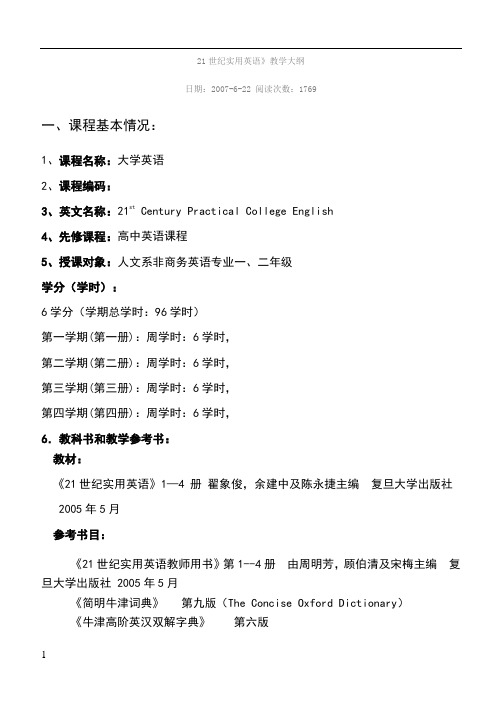
21世纪实用英语》教学大纲日期:2007-6-22 阅读次数:1769一、课程基本情况:1、课程名称:大学英语2、课程编码:3、英文名称:21st Century Practical College English4、先修课程:高中英语课程5、授课对象:人文系非商务英语专业一、二年级学分(学时):6学分(学期总学时:96学时)第一学期(第一册):周学时:6学时,第二学期(第二册):周学时:6学时,第三学期(第三册):周学时:6学时,第四学期(第四册):周学时:6学时,6.教科书和教学参考书:教材:《21世纪实用英语》1—4 册翟象俊,余建中及陈永捷主编复旦大学出版社2005年5月参考书目:《21世纪实用英语教师用书》第1--4册由周明芳,顾伯清及宋梅主编复旦大学出版社 2005年5月《简明牛津词典》第九版(The Concise Oxford Dictionary)《牛津高阶英汉双解字典》第六版二、本课程的地位、目的和任务:1、地位:非英语专业的大学英语课是非英语专业学生的必修课。
本课程的重要任务是指导高职高专学生巩固高中的综合英语知识,进一步强化英语的听说读写能力,帮助学生顺利通过英语应用能力考试,并能为参加大学英语四级考试和专转本考试打下坚实的基础。
2.目的和任务:本教程的教学目的在于注重培养听说能力,帮助学生提高英语交际能力;着眼于提高学生的职业技能和素质,使学生通过切合实际的学习过程打下良好的基础;使学生了解西方文化背景;将精读与泛读和扩展阅读融合一体,帮助学生全面提高听说读写译五种技能的训练与培养;帮助学生参加应用能力考试;引导学生开发各种学习潜能。
三、本课程的教学内容和要求第一学期(21世纪实用英语Book1)第一单元:6学时【主要内容】:(1) listening and speaking: Introducing yourself---getting to know people(2 )Text A : College A—Transition point in my life(3) Grammar review: verb tense (1)(4) Practical writing: Registration form(5) Text B: What I hope to gain from a college education(6) Text C: Devlin’s Advice(7) Basic reading skills: Reading for the main idea: Topic sentence (1)【重点、难点】:课文中的一些考核词汇, 句型结构,语法点及阅读和写作技巧【学生掌握要点】:活用课文中的重要短语和词汇;时态的巩固。
《21世纪实用英语》Unit 1 College Life 教案(B层)
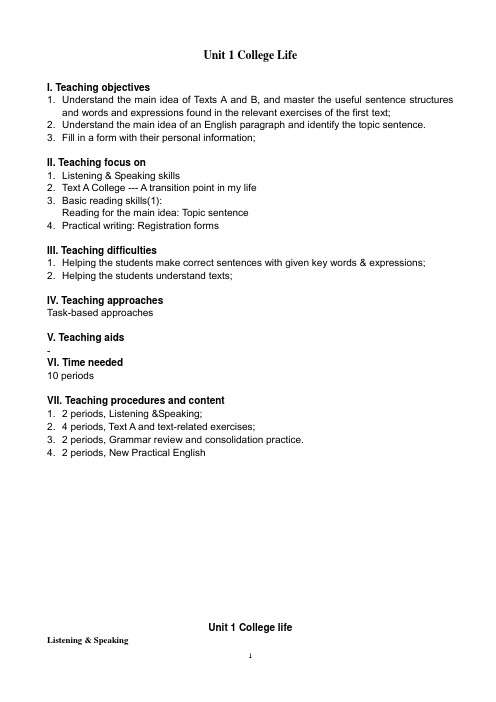
Unit 1 College LifeI. Teaching objectives1. Understand the main idea of Texts A and B, and master the useful sentence structuresand words and expressions found in the relevant exercises of the first text;2. Understand the main idea of an English paragraph and identify the topic sentence.3. Fill in a form with their personal information;II. Teaching focus on1. Listening & Speaking skills2. Text A College --- A transition point in my life3. Basic reading skills(1):Reading for the main idea: Topic sentence4. Practical writing: Registration formsIII. Teaching difficulties1. Helping the students make correct sentences with given key words & expressions;2. Helping the students understand texts;IV. Teaching approachesTask-based approachesV. Teaching aids-VI. Time needed10 periodsVII. Teaching procedures and content1. 2 periods, Listening &Speaking;2. 4 periods, Text A and text-related exercises;3. 2 periods, Grammar review and consolidation practice.4. 2 periods, New Practical EnglishUnit 1 College lifeListening & SpeakingLead inThe teacher explains the Lead-in so that the students will have some idea of what this unit is about. Then, the teacher writes the word “freshmen” on the blackboard and lets the studentsA. guess the meaning of the word;B. tell how they feel now that they are in college and what problems they have;C. have a look at the words and expressions in the box;D. watch the video and tell what is said in the video with help from the teacher;E. do the True or False exercise and watch the video again;F. exchange their views on life in college.Listening & SpeakingAfter the Lead-in, the teacher asks the students to do the following:1) Introducing YourselfA. Listen to the first half of the short talk in Ex. 1 twice and fill in the missing words;B. Listen to the second half of the short talk in Ex. 1 twice and fill in the missing words;C. Listen to the whole short talk and do Ex. 2.2) Getting to Know PeopleA. Go through the new words in Ex. 3 and listen to the conversation twice while filling in the missing words;B. Answer the questions by way of group discussion or the traditional teacher-student interaction;C. Do Ex. 4 in pairs;D. Go through the new words in Ex. 5 and watch the video twice while filling in the missing words;E. Do Ex. 6 in pairs. One student asks the question and the other student answers it. Then they switch roles anddo it again.3) Listening PracticeBefore ending class, the teacher tells the students how to do the exercises in Listening Practice as their homework. The teacher also tells the students that they should be prepared to answer the questions and give an oral presentation in class when they next come to class.Text A College – A Transition Point in My Life1) StarterAfter a brief explanation of the instructions, the teacherA. let the students list the things that they were excited and worried about when they first got to college. This can be done in complete English sentences or just phrases. If the students have difficulty doing this, the teacher should provide them with the following key words in English: (for things students may be excited about) beautiful campus, good library, teachers and classmates, the computer room, the environment, new way of life, etc.; and (for things students may be worried about) being away from home, the food, competition with other students, difficulties in study, washing clothes, taking a bath or shower, new teachers, etc.;B. organizes pair work or group discussion among the students, which should last for about 5 minutes only, and then gives the students 10 minutes to read Text A and find out the things that worried the writer when he first got to college.2) Text A: College — A Transition Point of My LifeThe teacherA. discusses the whole text with the students;B. guides the students through the exercises, focusing on certain items or leaving some exerci ses as the students’ homework a ccording to the students’ levels.Read the new words and expressionsParagraph 11. Transition: n. (instance of) changing from one state or condition to another 过渡;转变2. Title of Text A: Author Unknown: The name of this writer is not known. 佚名作者.Language Points1. Enter: vt. go or come into (a place) 进入 e.g. enter a room/ a house 进入房间/房子As soon as he entered the room, he saw his father and mother.他一进屋就看到了父母。
21世纪大学实用英语综合教程(第1册第5单元)
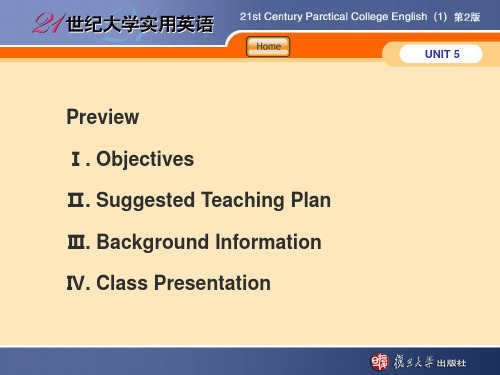
3. know clearly how to use the present simple and post simple
tenses of English;
4. know how to write a greeting card in English;
5. read a bunch of greetings for various occasions;
PREV.
NEXT
UNIT 5
Time Contents
Plan
3 periods Review of the listening and speaking skills the students have learned.
The teacher begins the assignment mainly to review the functional and notional language the students acquired in the previous unit. The teacher asks some students to answer the questions in Ex. 9 of the Listening and Speaking
D. Ask students one by one to repeat the requests and reply to them using the correct responses listed in Ex. 2.
PREV.
NEXT
UNIT 5
Time
Contents
Plan
2) Making Requests
Contents
Plan
C. Ask five indirect questions about the 1st dialogue to solicit both direct questions from the class and their corresponding answers, according to the dialogue;
21世纪大学英语1-2-3-4-5-7-6教案
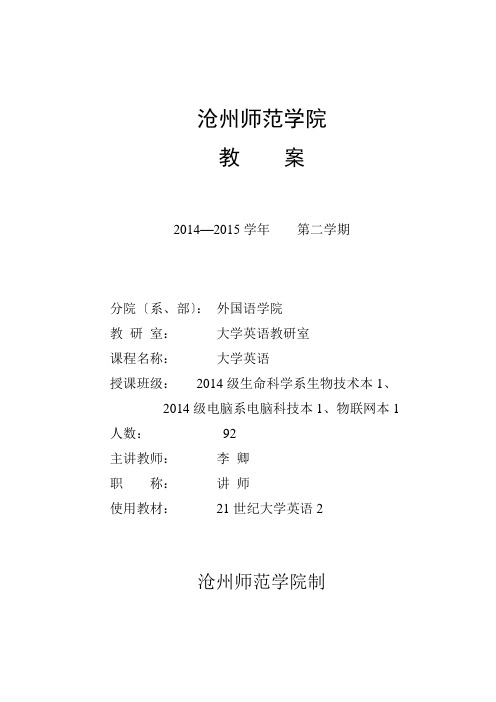
沧州师范学院教案2014—2015学年第二学期分院〔系、部〕:外国语学院教研室:大学英语教研室课程名称:大学英语授课班级:2014级生命科学系生物技术本1、2014级电脑系电脑科技本1、物联网本1 人数:92主讲教师:李卿职称:讲师使用教材:21世纪大学英语2沧州师范学院制2014--2015 学年度第2 学期外国语学院系、部,尊敬的李卿老师:本学期您将承担以下教学任务,请做好课前准备并按课表做好计划。
要求严格遵守教学工作标准,认真完成教学任务,积极改良教学方法,努力提高教学质量。
说明:1. 本表作为教师每学期承担教学任务的依据,由教研室、系部主管教学主任和任课教师签字后生效。
2. 本表由各系部负责填写一式三份,一份交教务处存档,一份发给任课教师,一份存入教师个人业务档案。
教案〔首页〕教学进度表生物技术本1、电脑科技本1、物联网本1班2014级科目:大学英语任课教师:李卿2015年03月01日注: 1、教学计划进度表填写要认真具体,日常教学要按此计划内容进行,如有变动需报教务处。
2、备注填写填写特殊教学形式,如:参观、见习、实验等,以及特殊教学内容、复习、考试或改变原计划内容增换新内容及特殊情况。
3、一式两份,系〔部〕存一份,自存一份。
Unit 1: Food and HealthPart A: Eating Food That’s Better for You, Organic or NotStep 1: StarterDirections: Put the words / expressions in the box into the correct categories.(anti-biotics, more healthy, poultry, food addictives, meat, more nutritious, synthetic pesticides, vegetables, less contaminated, growth hormone, diary, genetically modified organisms, chemical fertilizer, eggs, safer, drinks )Words / expressions for things that are not included in organic food:Words / expressions for possible advantages of organic food:Words /expressions for different kinds of organic food:Step 2: Theme-related InformationA: Directions: Enrich your vocabulary.society acceptable daily intake (ADI) 每人每日容许摄入量;appetite 食欲; dietary history 饮食习惯; eating out 出外用膳food grain other than wheat and rice 杂粮; food hygiene law 食品卫生法malnutrition 营养不良; metabolism 代谢; nutrient 营养素obesity 肥胖; vitamin 维生素B: Show students a picture of the food pyramid. It helps us know how to eat right. Eating right helps us stay healthy. There are 6 food groups in the pyramid.The sixth food group is fats and sweets. These foods taste good, but they are not good for us. We should eat less of them.The five main food groups are grains, fruits, vegetables, protein, and milk. We should eat foods from each of these groups every day.C: 10 healthy food: red wine; green tea; tomatoes; salmon, nuts; spinach; oats; broccoli; blueberries; garlic10 junk food: instant noodles; fried food; canned food; pickled food; preserved fruit; industrial food;ice cream; biscuits; barbeque ;carbonated drinkStep 3: Warm upA: Directions: Watch the video clip and do the exercise on P2. Or the teacher can read the passage with answers to train students’ listening skill.B: Discussion. (choose one of them)1. Why would people rather pay extra money for organic food?( Cues: chemicals; non-organically produced food; residue; pesticide; fertilizer)Suggested AnswersMany people just don’t trust those chemicals and don’t want to put them into their bodies. Since virtually all non-organically produced foods contain residues of pesticides, fertilizers and other chemicals, the only way to avoid them is to buy organic foods.2. Is organic farming less damaging to our environment? Why?( Cues: damaging; release; ecosystem; energy; waste)Suggested AnswersOrganic farming is less damaging to our environment for the following reasons:a. Organic farms do not consume or release synthetic pesticides into the environment—some of whichhave the potential to harm soil, water and local terrestrial and aquatic wildlife although it must be noted that organic pesticides still have the potential to be as damaging to the environment as synthetic pesticides.b. Organic farms are better than conventional farms at sustaining diverse ecosystems, i. e. populationsof plants and insects, as well as animals.c. When calculated per unit area, organic farms use less energy and produce less waste, e. g., wastesuch as packaging materials for chemicals.Step 4: Read the new words and phrases.Step 5: Fast reading for the exercise on P7-8.Step 6: Detailed learning of the text.Paragraph 11. take to— conceive a liking fore.g. Sandra took to it straight away. 桑德拉一眼就喜欢上了它。
21世纪大学实用英语说课课件

以学生为中 心,根据不 同教学内容 和不同专业 学生在基础、 兴趣、特长 上的差异, 灵活掌握教 学方法。
以教材为基 础,充分考 虑学生的基 础及需求, 灵活掌握教 材内容,适 当扩展课外 知识。
二、教材与教学内容
《21世纪大学实用英语》系列 教材是普通高等教育“十一五” 国家级规划教材,根据《高职 高专教育英语课程教学基本要 求》以及我国高职高专人才培 养特点编写而成,突出教学内 容的实用性和针对性,将语言 基础能力的培养与实际涉外交 际能力的训练有机地结合起来, 以满足21世纪全球化社会经济 发展对高职高专人才的要求。
三、学情及学习方法指导
知道简单的语音、 语法知识,掌握大约 3000左右的词汇量, 具有一定的英语基础 一部分学生基础不够 扎实,对英语缺乏 兴趣,对自己学好 英语缺少信心。
大多数学生希望掌握 英语学习技巧并达到 一定的英语水平。
学 情 分 析 结 论
学生水平参差不齐,大多数学生都具有了一定的英语基础并渴望 学好英语,希望能够通过学习,掌握学习语言的技巧和更多知识, 便于今后的学习和工作,但还有一部分学生基础不够扎实,也缺乏 学习兴趣,
复旦大学出版社
本学期教材
复旦大学出版社
本书为《基础教程》 和《基础教程综合练 习》,共10个单元, 每个单元均包括听说、 读写和实用技能训练 三大板块内容。
教学内容及课时安排
课时安排
听力部分
精读部分
考核方法
总成绩
平时成绩 40%
期末成绩 60%
出勤和作业 10%
课堂表现 10%
平时小考 20%
教学难点 如何提高学生对于英语的学习兴趣,使 其能够掌握、运用所学知识读懂一般的英 语文章,进行日常会话,达到其现阶段应 达到的英语水平,进而能够将其所学知识 用于实践,为一部分学生的进一步深造打 下基础,增加学生未来的就业优势。
21世纪大学实用英语综合教程第一册课程设计

21世纪大学实用英语综合教程第一册课程设计课程目标
本课程旨在帮助学生掌握初级英语听、说、读、写的基本技能,使其能够在日
常生活中进行简单的英语交流。
教学内容
1.英语日常用语。
包括问候、介绍、告别、道歉、致谢等基本用语。
2.常用英语语法。
包括基本时态、被动语态、名词、动词、形容词等语
言基础知识。
3.英语口语表达。
包括简单的自我介绍、问路、点餐、购物等基本口语
表达。
4.阅读理解。
包括简单的短文阅读、根据文章填空、选词填空、判断正
误等阅读理解练习。
5.英语写作。
包括简单的日记、电子邮件、便条、短信等基础写作练习。
教学安排
本课程安排为五周,每周授课6小时,具体教学安排如下:
第一周
授课主题:英语日常用语
授课内容:
1.英语问候语和介绍自己。
2.日常的常用词汇和表达。
3.英语口语练习。
1。
21世纪大学英语1教学大纲
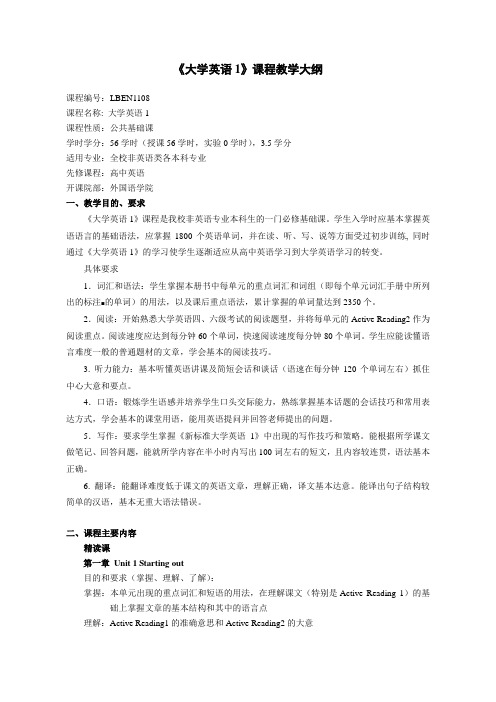
《大学英语1》课程教学大纲课程编号:LBEN1108课程名称: 大学英语1课程性质:公共基础课学时学分:56学时(授课56学时,实验0学时),3.5学分适用专业:全校非英语类各本科专业先修课程:高中英语开课院部:外国语学院一、教学目的、要求《大学英语1》课程是我校非英语专业本科生的一门必修基础课。
学生入学时应基本掌握英语语言的基础语法,应掌握1800个英语单词,并在读、听、写、说等方面受过初步训练, 同时通过《大学英语1》的学习使学生逐渐适应从高中英语学习到大学英语学习的转变。
具体要求1.词汇和语法:学生掌握本册书中每单元的重点词汇和词组(即每个单元词汇手册中所列出的标注■的单词)的用法,以及课后重点语法,累计掌握的单词量达到2350个。
2.阅读:开始熟悉大学英语四、六级考试的阅读题型,并将每单元的Active Reading2作为阅读重点。
阅读速度应达到每分钟60个单词,快速阅读速度每分钟80个单词。
学生应能读懂语言难度一般的普通题材的文章,学会基本的阅读技巧。
3. 听力能力:基本听懂英语讲课及简短会话和谈话(语速在每分钟120个单词左右)抓住中心大意和要点。
4.口语:锻炼学生语感并培养学生口头交际能力,熟练掌握基本话题的会话技巧和常用表达方式,学会基本的课堂用语,能用英语提问并回答老师提出的问题。
5.写作:要求学生掌握《新标准大学英语1》中出现的写作技巧和策略。
能根据所学课文做笔记、回答问题,能就所学内容在半小时内写出100词左右的短文,且内容较连贯,语法基本正确。
6. 翻译:能翻译难度低于课文的英语文章,理解正确,译文基本达意。
能译出句子结构较简单的汉语,基本无重大语法错误。
二、课程主要内容精读课第一章Unit 1 Starting out目的和要求(掌握、理解、了解):掌握:本单元出现的重点词汇和短语的用法,在理解课文(特别是Active Reading 1)的基础上掌握文章的基本结构和其中的语言点理解:Active Reading1的准确意思和Active Reading2的大意了解:通过夸张的手法达到幽默效果的写作技巧,及推测的阅读技巧,简单了解英国的教育体系相关内容主要内容:Active Reading1的学习和其配备练习重点与难点:1. 重点词汇:residence, barely, muscle, spill, sip, intelligent, gap, ignorant, sign, assure2. 重点短语:check in, go along, sign up for, rent out, burst into tears/song/laughter, run out of3. 语法:with/without的用法第二章Unit 2 Food, glorious food!目的和要求(掌握、理解、了解):掌握:本单元出现的重点词汇和短语的用法,在理解课文(特别是Active Reading 1)的基础上掌握文章的基本结构和其中的语言点理解:Active Reading1的准确意思和Active Reading2的大意了解:如何推测文章的言外之意的阅读技巧及对外国的成人礼的了解主要内容:Active Reading1的学习和其配备练习重点与难点:1. 重点词汇:frown, nonsense, frank, nasty, resort, enormous, portion, cling, yummy, juicy,gloomy, emotion, innocence, region, complain, perception, discard, implement,crack, scrape, despair, bake, slippery2. 重点短语:to be frank, come of age, a battery of3. 语法:非限定性从句及省略第三章Unit 3 Learning to think目的和要求(掌握、理解、了解):掌握:本单元出现的重点词汇和短语的用法,在理解课文(特别是Active Reading 2)的基础上掌握文章的基本结构和其中的语言点理解:Active Reading1的大意和Active Reading2 的准确意思了解:在大学里的学习技巧主要内容:Active Reading2的学习和其配备练习重点与难点:1. 重点词汇:financial, resource, transfer, context, detail, critical, integrate, identify, generate,solve, logical, rational, scheme, creative, setting, overwhelm, effective, vary,recall, contrast, structure, thrust, extent, parliament2. 重点短语:focus on/upon, strike a balance, more or less, try sth out, bog down in/with, breakup, keep sth in mind, by/in contrast, work out3. 语法:while/when +分词的用法及主谓倒装第四章Unit 4 Person to person目的和要求(掌握、理解、了解):掌握:本单元出现的重点词汇和短语的用法,在理解课文(特别是Active Reading 1)的基础上掌握文章的基本结构和其中的语言点理解:Active Reading1的准确意思和Active Reading2的大意了解:在写作过程中的省略及使用手机的好处和坏处主要内容:Active Reading1的学习和其配备练习重点与难点:1. 重点词汇:factor, impact, whereas, extend, necessarily, tedious, practically, impulse, essential,fuss, bold, risky, solitary, speculate, utter, therapy, interfere, distract, undoubtedly 2. 重点短语:make an impact on, beyond/within the reach of, switch off, be meant to do, end up,on the plus side, on impulse, check up on, switch on, make a fuss (about/over),get hold of sb3. 语法:it + passive voice及what引导的强调结构第五章Unit 5 All you need is love目的和要求(掌握、理解、了解):掌握:本单元出现的重点词汇和短语的用法,在理解课文(特别是Active Reading 1)的基础上掌握文章的基本结构和其中的语言点理解:Active Reading1的准确意思和Active Reading2的大意了解:了解著作《呼啸山庄》的大概内容并了解小说语言的特点。
21世纪实用英语综合教程1 导教导学案

21世纪实用英语综合教程1 导教导学案In the 21st century, the need for practical and comprehensive English language instruction has become increasingly crucial. As the world becomes more interconnected, the ability to effectively communicate in English has become a valuable asset not only for academic and professional pursuits but also for personal growth and cultural exchange. This essay aims to provide a comprehensive guide for the development and implementation of a 21st-century practical English integrated instruction program, focusing on the guidance for both teaching and learning.Firstly, the curriculum design for a 21st-century practical English integrated instruction program should be tailored to the specific needs and goals of the target learners. This may involve conducting a thorough needs analysis to understand the learners' language proficiency levels, learning styles, and desired outcomes. Based on this information, the curriculum can be designed to address the learners' strengths, weaknesses, and areas for improvement, ensuring that the instruction is relevant, engaging, and effective.One key aspect of the curriculum design should be the integration of various language skills, including reading, writing, listening, and speaking. Rather than treating these skills in isolation, the instruction should focus on developing the learners' ability to seamlessly apply these skills in real-world scenarios. This can be achieved through the use of authentic materials, such as news articles, podcasts, and videos, as well as task-based learning activities that simulate real-life communication situations.Furthermore, the curriculum should incorporate a strong emphasis on the development of critical thinking and problem-solving skills. In the 21st century, the ability to analyze information, think critically, and devise creative solutions to complex problems has become increasingly valuable. By integrating these skills into the English language instruction, learners can not only improve their language proficiency but also enhance their overall cognitive abilities and adaptability in a rapidly changing global landscape.Another crucial component of the 21st-century practical English integrated instruction program is the incorporation of technology-enhanced learning. The use of digital tools and platforms can significantly enhance the learning experience, providing learners with access to a wealth of resources, interactive activities, and collaborative opportunities. This can include the use of online language learning platforms, virtual classrooms, and multimedia-based instructional materials.However, the integration of technology should be done thoughtfully and strategically, ensuring that it enhances rather than distracts from the learning process. Instructors should be trained in the effective use of technology-enhanced learning tools and should be able to seamlessly integrate them into their teaching practices.In addition to the curriculum design and technology integration, the success of a 21st-century practical English integrated instruction program also depends on the quality of the teaching staff. Instructors should be highly proficient in the English language, with a deep understanding of language acquisition principles and effective teaching methodologies. They should also be committed to ongoing professional development, staying up-to-date with the latest research and best practices in the field of English language instruction.Instructors should be skilled in creating a learning environment that is engaging, interactive, and supportive. This may involve the use of a variety of teaching strategies, such as group discussions, role-playing activities, and project-based learning. Additionally, instructors should be adept at providing constructive feedback and personalized support to learners, helping them to identify their strengths, weaknesses, and areas for improvement.Another crucial aspect of the 21st-century practical English integrated instruction program is the emphasis on learner autonomy and self-directed learning. Learners should be encouraged to take an active role in their own learning, setting personal goals, and engaging in self-reflection and self-assessment. This can be achieved through the incorporation of learning strategies, such as goal-setting, time management, and self-monitoring, which can empower learners to become more independent and responsible for their own learning progress.Furthermore, the program should foster a collaborative learning environment, where learners can engage in peer-to-peer interactions, share knowledge and resources, and provide mutual support and feedback. This can be facilitated through the use of group-based activities, online discussion forums, and collaborative project work.Finally, the success of a 21st-century practical English integrated instruction program should be evaluated through a comprehensive assessment system that measures not only language proficiency but also the development of critical thinking, problem-solving, and other essential 21st-century skills. This may involve the use of a variety of assessment tools, such as standardized tests, performance-based assessments, and portfolio-based evaluations, to provide a well-rounded and accurate evaluation of the learners' progress andachievements.In conclusion, the development and implementation of a 21st-century practical English integrated instruction program require a multifaceted approach that addresses the evolving needs and demands of the modern global landscape. By focusing on curriculum design, technology integration, teaching quality, learner autonomy, and comprehensive assessment, educators can create a learning environment that empowers learners to develop the language skills, critical thinking abilities, and adaptability necessary for success in the 21st century.。
21世纪大学实用英语导学1复旦大学课程设计
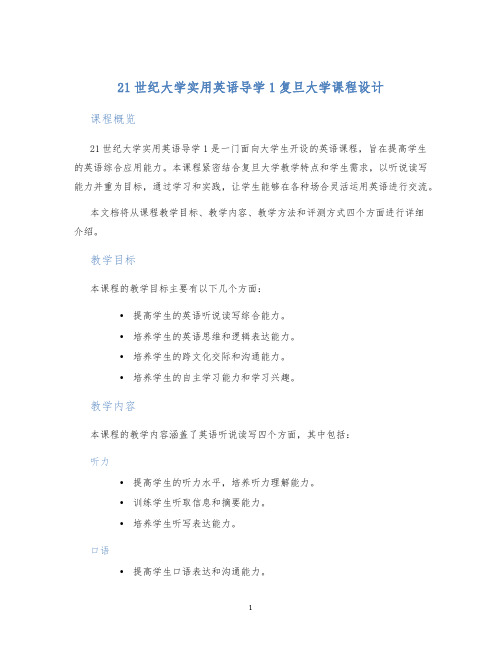
21世纪大学实用英语导学1复旦大学课程设计课程概览21世纪大学实用英语导学1是一门面向大学生开设的英语课程,旨在提高学生的英语综合应用能力。
本课程紧密结合复旦大学教学特点和学生需求,以听说读写能力并重为目标,通过学习和实践,让学生能够在各种场合灵活运用英语进行交流。
本文档将从课程教学目标、教学内容、教学方法和评测方式四个方面进行详细介绍。
教学目标本课程的教学目标主要有以下几个方面:•提高学生的英语听说读写综合能力。
•培养学生的英语思维和逻辑表达能力。
•培养学生的跨文化交际和沟通能力。
•培养学生的自主学习能力和学习兴趣。
教学内容本课程的教学内容涵盖了英语听说读写四个方面,其中包括:听力•提高学生的听力水平,培养听力理解能力。
•训练学生听取信息和摘要能力。
•培养学生听写表达能力。
口语•提高学生口语表达和沟通能力。
•强化学生口语自我表达能力。
•增强学生口语场景运用能力。
阅读•提高学生英语阅读水平和速度。
•提升学生阅读能力和理解能力。
•强化学生阅读自我学习能力。
写作•培养学生独立写作能力。
•提高学生写作逻辑和表达能力。
•加强学生写作场景运用能力。
教学方法教学方法是本课程最为关键的部分之一,采用了以下几种教学方法:课堂教学•引导学生发言交流。
•组织小组讨论和合作学习。
•进行演讲和演示。
在线教学•利用MOOC平台在线授课。
•提供数字化资源学习。
•通过网络交流互动。
实践教学•参加线下小组讨论和辩论活动。
•参加角色扮演和现实场景模拟训练。
•实地参观和交流实践项目。
评测方式本课程采用多种评测方式进行学习效果的评估,主要包括:考试评测•阅读理解和书面表达评测。
•口语讲述和演讲评测。
•听力理解和写作评测。
项目评测•个人独立项目评测。
•所属小组合作项目评测。
•实地参观和交流项目评测。
课堂行为评测•个人出勤率和课堂互动表现评测。
•个人作业和课堂任务完成度评测。
•参与讨论和互动对课堂的贡献评测。
结语21世纪大学实用英语导学1是一门面向全球大学生的英语实践课程,本文档以课程教学目标、内容、方法和评估方法进行了详细介绍。
21世纪大学英语1教案

教学目标:1. 理解课文主题,提高学生的阅读理解能力。
2. 培养学生的词汇积累和语法运用能力。
3. 增强学生的口语表达能力,提高听力水平。
4. 培养学生的跨文化交际意识。
教学重点:1. 课文内容理解2. 词汇和语法知识3. 口语表达和听力训练教学难点:1. 课文内容的深入理解2. 词汇和语法的灵活运用教学过程:一、导入(10分钟)1. 通过图片、视频或简短讨论,激发学生对课文主题的兴趣。
2. 引导学生思考与课文主题相关的问题,如:梦想、目标、努力等。
二、课文阅读(20分钟)1. 学生阅读课文,理解文章大意。
2. 教师提问,检查学生对课文内容的理解。
3. 分析课文中的重点词汇和语法结构,讲解例句。
三、词汇和语法学习(15分钟)1. 教师讲解课文中的重点词汇和语法知识,如:aspire、hu、change the form 等。
2. 学生练习词汇和语法,如:填空、改写句子等。
3. 教师点评学生的练习,纠正错误。
四、口语表达(15分钟)1. 学生分组进行角色扮演,模拟课文中的情景。
2. 学生用英语进行口语交流,提高口语表达能力。
3. 教师点评学生的口语表现,提出改进建议。
五、听力训练(15分钟)1. 播放课文录音,学生认真听讲。
2. 教师提问,检查学生对听力材料的理解。
3. 分析听力材料中的重点词汇和语法结构,讲解例句。
六、总结与作业布置(10分钟)1. 教师总结本节课的重点内容,强调学生的掌握情况。
2. 布置课后作业,如:课文翻译、词汇记忆、语法练习等。
教学反思:本节课通过多种教学手段,如:阅读、口语、听力等,帮助学生全面提高英语能力。
在教学过程中,应注意以下几点:1. 关注学生的个体差异,因材施教。
2. 注重学生的参与度,鼓励学生积极参与课堂活动。
3. 适时调整教学进度,确保教学目标的实现。
4. 培养学生的跨文化交际意识,提高学生的综合素质。
课后作业:1. 课文翻译(A篇)2. 词汇记忆(课文中的重点词汇)3. 语法练习(课文中的重点语法结构)备注:教师可根据实际情况调整教学内容和进度。
21世纪1电子教案Unit6
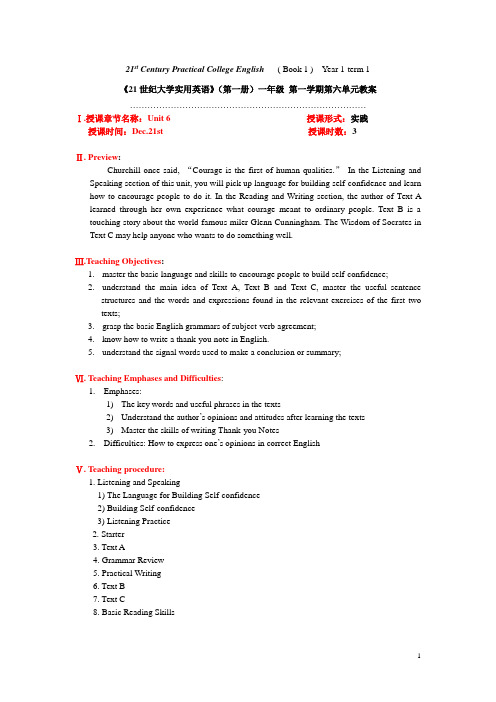
21st Century Practical College English ( Book 1 ) Year 1-term 1《21世纪大学实用英语》(第一册)一年级第一学期第六单元教案………………………………………………………………………Ⅰ.授课章节名称:Unit 6 授课形式:实践授课时间:Dec.21st 授课时数:3Ⅱ.Preview:Churchill once said, “Courage is the first of human qualities.”In the Listening and Speaking section of this unit, you will pick up language for building self-confidence and learn how to encourage people to do it. In the Reading and Writing section, the author of Text A learned through her own experience what courage meant to ordinary people. Text B is a touching story about the world-famous miler Glenn Cunningham. The Wisdom of Socrates in Text C may help anyone who wants to do something well.Ⅲ.Teaching Objectives:1.master the basic language and skills to encourage people to build self-confidence;2.understand the main idea of Text A, Text B and Text C, master the useful sentencestructures and the words and expressions found in the relevant exercises of the first two texts;3.grasp the basic English grammars of subject-verb agreement;4.know how to write a thank-you note in English.5.understand the signal words used to make a conclusion or summary;Ⅵ.Teaching Emphases and Difficulties:1.Emphases:1)The key words and useful phrases in the texts2)Understand the author‟s opinions and attitudes after learning the texts3)Master the skills of writing Thank-you Notes2.Difficulties: How to express one‟s opinions in correct EnglishⅤ. Teaching procedure:1. Listening and Speaking1) The Language for Building Self-confidence2) Building Self-confidence3) Listening Practice2. Starter3. Text A4. Grammar Review5. Practical Writing6. Text B7. Text C8. Basic Reading Skills课外作业:复习本课单词预习课文教学体会:在课堂教学中,让学生在英语学习情景中分析和表达自己的观点,培养学生的合作互助精神,逐步体验到用英语交流的成功与喜悦。
21世纪大学实用英语全新版第一册第三单元教案

Text AMagellan’s Madness
Exercises
Text BMarco Polo’s Big, Big World
Exercises
PracticalReading
Text AMagellan’sMadness
Para. 1 of Text A
Questions about This Paragraph
market survey市场调查
Nothing special.没啥特别的。
go online上网
target //n.目标
Script:
Linda:Do you have any idea how to do a market survey, Andrew?
Andrew:No special idea, no.
Useful Language
give up放弃
riskya.危险的
unique / a.独特的
fail v.失败
have a go at it尝试一下
Script:David:Do you have an idea, Linda?
Linda:Not yet.
David:I give up, let’s do as usual. Otherwise it can be risky.
David: You are so stubborn
Step 3.Linda and Andrew are discussing how to do a market survey. Listen to their conversation, and then answer the questions by choosing the best answer. First getting to know the following useful language might be helpful.
21世纪大学英语第一册unit1教案
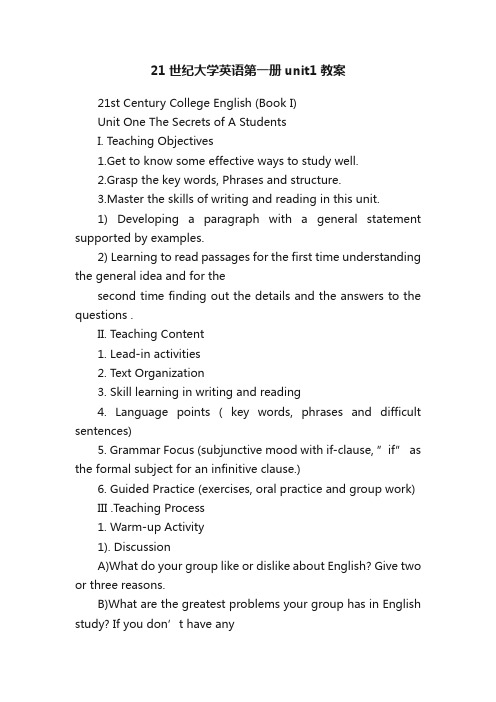
21世纪大学英语第一册unit1教案21st Century College English (Book I)Unit One The Secrets of A StudentsI. Teaching Objectives1.Get to know some effective ways to study well.2.Grasp the key words, Phrases and structure.3.Master the skills of writing and reading in this unit.1) Developing a paragraph with a general statement supported by examples.2) Learning to read passages for the first time understanding the general idea and for thesecond time finding out the details and the answers to the questions .II. Teaching Content1. Lead-in activities2. Text Organization3. Skill learning in writing and reading4. Language points ( key words, phrases and difficult sentences)5. Grammar Focus (subjunctive mood with if-clause, ”if” as the formal subject for an infinitive clause.)6. Guided Practice (exercises, oral practice and group work)III .Teaching Process1. Warm-up Activity1). DiscussionA)What do your group like or dislike about English? Give two or three reasons.B)What are the greatest problems your group has in English study? If you don’t have anyproblems, recommend, as a group, two or three study effective habits your group find .C)English is a required course for most college students. Apart from passing exams, are thereany other reasons for studying English?2). Questions about the TextA)Based on the title, guess what the text is about.B)Look at the subheadings, 1-8, in the text. Which of these activities have you already done?In which areas do you feel you need improvement?C)Are there any “secrets” to your own success as a student? In other words, do you have anyspecial study techniques which have been very successful for you?3) Background InformationA) grading systemGrading is just a means for teachers to measure and assess students study. There ususlly are two grading system: the five-grade-marking system and percentage scales.(五分制和百分制)Schools, colleges and universities in Great Britian and the United States commonly use letter grades to indicate the quality of a student’s academic performance: A (excellent), B (good), C (average), D (below average), and F (failing). In the United States, work rated C or above isususlly required of an undergraduate student to continue his / her studies; work rated B or higher is usully required of a graduate student to continue. In percentage scales, 100 percent is the highest mark, and 70 percent (or 65 percent) is usually the lowest passing mark.B). students at universityA university student who has not yet taken his or her first, or “bachelor’s” degree is an undergraduate. In the United States, a first-year student at a college or university, and in a high school as well, is called a freshman, a second-year student a sophomore, and a third-year student a junior, and a fourth-year student a senior. A graduate is a person who has completed a university degree course while a posrgraduate (or graduate in the United States) is a person doing studies that are done at a university after one has received a first degree.C) speed-readingAlso known as rapid reading, speed-reading is a method of reading rapidly by skimming and scanning. The aim is to increase the number of words read in a certain length of time, as well as the reader’s comprehensi on of the text.2. Text OrganizationPart I (para.1-para. 3) presenting the importance of the study skills by two specific examples. Part II (para.4- para.12) giving the 8 study skills concretely3. Skill learning in writing and reading1) Reading skill: read the assigned passage twice. The first time concentrate on understandingthe general ideas and on the second reading concentrate on the details and any questions in your mind after the first reading. please take Text B and Text C as your reading materials and finally you will become an efficient reader.2) Writing skill:The type of writing is an exposition.This text is a ty pical “how-to-do-things essay”. This kind of article is ususlly divided into two parts: Part 1, the importance of doing this; Part 2, the concrete methods or procedures ofdoing it. And the second part is the main body of the article.Generally spe aking, there’s a topic sentence at the beginning of the text to express the thesis and a conclusive sentence in the end.In this text, after the examples at the beginning, the author tells us the topic sentence “The students at the top of the class get there by mastering a few basic techniques that others can easily learn.”. To match the topic sentence, the author gives us the conclusion s entence “After all, the secrets of A students are not so secret. You can learn and master them and become anA studen t, too.”.4. Language Points1)perform Para. 2 vt/vi.A)) do; accomplish; carry out.B)) act, play, sing or do (tricks) before audience.eg. When will the play be ~ed?The surgeon was ~ing a dangerous operation.performance n. carrying, acting out, playing musiceg. He is excellent in the ~ of his duties.His ~ of Hamlet was very good.performer n. the person who act, play, practice and carry out[C] perform one’s job perform an experimentperform calculation perform an operationa good/bad performance perform a trickperform one’s promise give two performances a day2) high-achieving para. 3 adj. high-scoring/getting high marks[C] high-achieving students[O] underachieving adj . lower-scoring adj.3) concentrate para. 4 vt/vi direct (attention ,efforts, etc) to a point of focuseg. He ~d his energies on studying.The soldiers ~d outside the town for the attack.concentrated adj. asembled, intense, be absorbed inconcentration n. getting involved in;people and soldiers absembling;eg. He lacks ~.[C] concentrate one’s attention on/upon/towards sth. concentrate one’s efforts on/upon/towards sth. concentrate one’s thoughts on/upon/towards sth.concentrate the troops concentrated juice concentration camp [S] focus v. A)) ~ (on), (cause to) come together at a focus; adjust (an instrument, etc.)so that it is in focus B)) ~ on, concentratefocus on sth. focus one’s anger on sth.focus one’s attentio n/thoughts on a problemfocus the lens of a microscope4) interruption n. break; disruptioneg. Numerous ~s have prevented me from finishing the work.I get too many ~s in my work.interrupt v.A) break the continuity of B) break in upon ( a person’s action, speech, etc.) eg. The war ~ed the flow of commerce between the two countries.Traffic was ~ed by floods.Those trees are growing so high that they ~ the view.interrupter n.[C] an annoying interruption without interruptionservice interruption temporary interruptioninterruption of telephone communication5) ignore vt. Take no notice of; refuse to pay attention to para.5eg. He ~d my advice. The driver ~d the traffic light.ignorance n.eg. His failure resulted from his ~.Do you mean you were in complete ~ of the fact?ignorant a.ill-informed, lacking in knowledge, silly ignorantly adv.eg. I’m ~ about politics.I was ~ (of the fact) that the boss could be so strict.[C] ignore something ignore somebody ignore personal dangerbe ignorant of / be in ignorance of something[P] Ignorance is bliss. 无知便是福。
大学英语教学计划
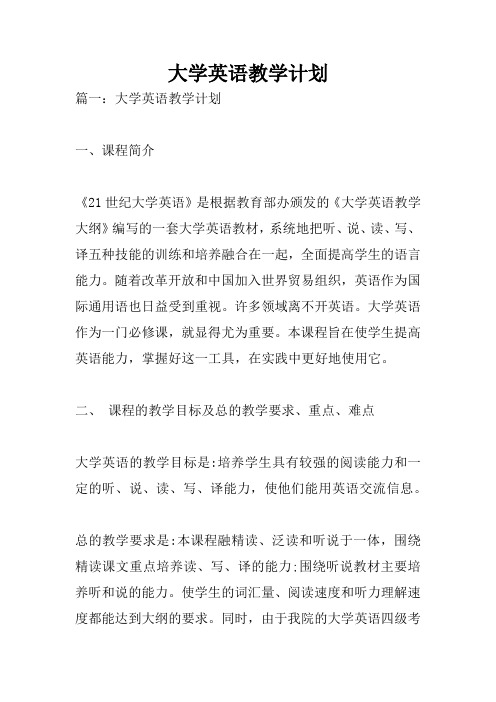
大学英语教学计划篇一:大学英语教学计划一、课程简介《21世纪大学英语》是根据教育部办颁发的《大学英语教学大纲》编写的一套大学英语教材,系统地把听、说、读、写、译五种技能的训练和培养融合在一起,全面提高学生的语言能力。
随着改革开放和中国加入世界贸易组织,英语作为国际通用语也日益受到重视。
许多领域离不开英语。
大学英语作为一门必修课,就显得尤为重要。
本课程旨在使学生提高英语能力,掌握好这一工具,在实践中更好地使用它。
二、课程的教学目标及总的教学要求、重点、难点大学英语的教学目标是:培养学生具有较强的阅读能力和一定的听、说、读、写、译能力,使他们能用英语交流信息。
总的教学要求是:本课程融精读、泛读和听说于一体,围绕精读课文重点培养读、写、译的能力;围绕听说教材主要培养听和说的能力。
使学生的词汇量、阅读速度和听力理解速度都能达到大纲的要求。
同时,由于我院的大学英语四级考试的通过率一向较高,我们要保证大多数学生能够一次性通过考试,并且能够在实际使用中运用自如。
课程的重点及难点是:重点是培养学生的读、写、译的能力;难点是对文章结构进行分析,提高写作和翻译技能,培养学生用口语交流的能力。
三、课程性质公共基础必修课。
对象为xx级本部普通班和东方学院各班。
四、教学时间的安排本学期03级大学英语普通班和东方班从第一周开始上课,第十九周结束,每周授课时数为5学时。
精读教材采用《21世纪大学英语》,计划完成第二册第五单元至第三册第二单元的内容。
每个单元计划用两个教学周完成。
在校历第十周安排期中考试,考察第二册第五单元至第八单元的内容,考试以随堂方式进行。
本学期安排三次四级模拟考试,考试以随堂方式进行。
每一单元课文a讲解单词、词组、课文结构、重点难点、课文主旨及课后练习;课文b在课堂上适当讲解;课文c要求并监督学生在课外阅读学习。
此外,要充分利用学生手上的练习册,对练习册上难度较大的练习应给予必要的讲解。
听力教材采用《大学英语听说教程》,每两周安排一次听力课,共9次,每次2学时,共18学时。
- 1、下载文档前请自行甄别文档内容的完整性,平台不提供额外的编辑、内容补充、找答案等附加服务。
- 2、"仅部分预览"的文档,不可在线预览部分如存在完整性等问题,可反馈申请退款(可完整预览的文档不适用该条件!)。
- 3、如文档侵犯您的权益,请联系客服反馈,我们会尽快为您处理(人工客服工作时间:9:00-18:30)。
21世纪大学实用英语教学计划
文科部:姚立佳
一、课程性质及要求
该课程教学内容的实用性和针对性突出,语言基本能力的培养与实际涉外交际能力的训练的有机结合,从而能够满足21世纪全球化社会经济发展对高职高专人才的要求。
听说、读写、实用技能训练三大板块能够从多方面加强学生的英语运用能力。
通过对课文的学习以及课后的练习,全面提高学生的英语应用能力,帮助其通过全国的高等学校英语应用能力考试,并为其所学的专业服务。
二、教学主要内容及学时分配
共8 单元,每一单元用8 课时,共用4 个月时间
(一)听说训练(2课时)
听力部分通过最初的反复练习到强化训练提高学生的听力水平。
再通过给话题开展
对话的方式使学生开口说英语,从而提高听说能力。
(二)课文讲解(4课时)
三篇课文(Text A, Text B and Text C)分别按精读、泛读和扩展阅读的要求讲
解,掌握大纲规定的词汇、句型和语法,提高学生的阅读速度和阅读质量。
(三)语法讲解和课后练习(2课时)
以系统复习英语语法为主,练习重点放在学生容易混淆、容易出错的语法现象上。
通过练习掌握课文所学内容和语法点。
三、教学基本要求
(一)理解课文的内容并掌握其中的关键词语、词组、固定搭配以及句型,并且通过课后的练习题能够达到熟练应用的程度。
(二)对语法的学习加强学生的语法功底
(三)学习阅读以及写作的技巧并在练习当中加以运用,从多方面丰富学生的知识,开阔他们的视野并为其提供思考的素材。
从听、说、读、写、译等各方面训练学生的能
力,从而全面提高学生的英语实际运用水平。
四、教学指南
(一)注重培养听说能力
以听说为重点,把听、说、读、写、译的技能有机的结合起来,使学生的听说训练贯穿于课程教学的始终。
(二)着眼于提高学生的职业技能和素质
通过提供相关的实用训练,力求使学生在学习的过程中打下一定的基础,在日常或涉外工作时能更加熟练的掌握和使用英语。
(三)扩展词汇量、提高阅读速度和质量
精读、泛读和扩展阅读提高学生的阅读速度和阅读质量
(四)介绍西方文化背景
将文化内容于语言材料相融合,从而介绍西方文化知识,为更好的学好英语奠定基础。
